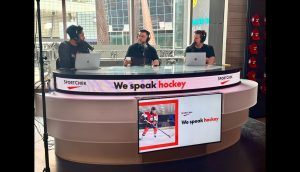Bell Media can now dynamically insert ads into its shows
One of MiC’s most-read stories of the year was about tech that merged the old with the new.
At the beginning of the year, Bell Media unveiled a new advertiser opportunity that would use AI to dynamically put products and ads into its productions. Those could be ads that are put onto billboards and taxis already in the scenes, or inserting the product into a shelf in the scene. It worked with TD to try on the tech on Children Run Everything in February, followed by Johnson & Johnson working Tylenol into an episode of Transplant.
MiQ appoints new SVP of commercial operations in Canada
Rebecca Shropshire, formerly head of agency development at Meta in addition to several other programmatic industry roles, joined MiQ this fall as SVP of its commercial operations to oversee a unified commercial strategy for the company.
On top of further developing its digital OOH capabilities, 2022 also saw MiQ stake its claim in the connected TV space, whether it was through big partnerships with Bell Media or taking a proactive approach to detecting fraud on the emerging platform.
Samsung Ads has new ad inventory for its four million smart TVs
While the ad industry has been laser-focused on connected TV this year, it has been, for the most part, largely preparing for what’s to come. Penetration for smart TV devices still has a lot of room to grow in Canada, and what ad inventory is currently available is going for a premium.
Which it should be no surprise that readers took notice when Samsung made a lot more ad inventory available to the Canadian market back in the spring. Among the new products was an Addressable Program Guide that aggregates live channels through various input sources, including terrestrial antennas and Samsung TV Plus, with native ads directly integrated. The company also launched Discovery Masthead, a feature previously launched in other markets that place ads in environments where viewers are looking to discover new content.
Google’s move from FLoC to Topics? Media execs remain skeptical
Early this year, Google scrapped its previous plan for a post-cookie ad targeting system. It came after criticism from privacy advocates, who had found ways in which FLoC data could be traced back to an individual user and saw numerous ways in which the data could potentially be used for discriminatory purposes. Many in the ad industry also had issues with FLoC, but those were more centred on its complexity, and a lack of transparency it brought with it.
Google’s new Privacy Sandbox targeting method, dubbed Topics, seemed to be geared more towards addressing privacy concerns than ensuring the effectiveness of ad targeting. But many media execs MiC spoke to seemed to be in favour of the more sound privacy approach – though some expressed concerns over new challenges it presented advertisers, as well as different transparency issues they saw could be forthcoming.
In the summer, to give the industry more time to test and learn about its new ad targeting framework, Google pushed back its phase out of third party cookies to the second half of 2024.
Tech layoffs are beginning to concern media agencies
A mix of platform-side targeting changes and a downturn in ad investments ahead of a recession means many ad-supported digital and social media companies began feeling the pressure on their bottom line in the summer. It came to a head in the fall, when the list of companies that had been forced to lay off significant portions of staff grew to include Snap, Amazon, Meta and Twitter. Though Google has yet to announce similar levels of staff reduction, it has dramatically slowed down hiring activity, and CEO Sundar Pichai has warned of difficult decisions on the horizon.
This is, inevitably, beginning to worry executives at media agencies. On the one hand, they are concerned that downsizing will lessen these companies’ ability to innovate and develop new ad products, but on the other, they are also simply worried about their capacity to service agencies and their clients. And in the case of Twitter, there has been the added concern about content moderation teams and their ability to ensure a brand-safe environment.
























